As the compact SUV segment continues to grow in popularity, two strong contenders stand out: the Hyundai Kona and the Volkswagen T-Roc. Both models bring their own unique blend of style, technology, and performance to the table. In this article, we take a closer look at their technical specifications and innovations to see how they compare.
Hyundai Kona vs VW T-Roc – Performance, range & efficiency compared
Two cars, one duel: Hyundai Kona meets VW T-Roc.
Which one wins in performance, efficiency and value for money? Find out now!
Engine Options and Performance
The Hyundai Kona offers a versatile lineup that includes petrol, full hybrid, and electric engines. With power outputs ranging from 100 to 218 HP, it caters to a wide range of driving preferences. The electric variant boasts an impressive range of up to 514 km on a single charge, along with a top speed of 201 km/h. Meanwhile, the T-Roc is more limited with petrol and diesel options, providing performance from 115 to a robust 300 HP, with a maximum speed reaching up to 250 km/h.
Acceleration is a noteworthy aspect for both vehicles. The Kona's fastest variant can reach highway speeds in just 7.8 seconds, while the T-Roc impressive performance cars can do this in as little as 4.9 seconds. This indicates that performance enthusiasts may gravitate more towards the T-Roc, while those seeking efficiency might prefer the Kona.
Fuel Efficiency and Environmental Considerations
When it comes to fuel efficiency, both models showcase attractive consumption rates. The Kona achieves between 4.5 to 6.7 L/100 km, depending on the engine type. The T-Roc, conversely, records slightly higher consumption rates, ranging from 4.7 to 8.5 L/100 km. The Kona's electric model performs exceptionally well with a consumption of 14.6 kWh/100 km, affirming its ecological credentials, especially in urban settings.
Interior Space and Comfort
Space is a key factor in the SUV category, and both the Kona and T-Roc are designed with practicality in mind. The Hyundai Kona offers a trunk capacity of 466 liters, significantly larger than the T-Roc's maximum of 445 liters. Both vehicles comfortably seat five, but the Kona’s spacious interior is particularly appealing for families and travelers alike.
Technological Features and Innovations
The Kona prides itself on its technological advancements with features like a fully digital cockpit, advanced connectivity options, and an intuitive infotainment system that seamlessly incorporates smartphone integration. Hyundai provides a suite of safety technologies, including adaptive cruise control and lane-keeping assist, enhancing driver confidence.
The T-Roc also excels in technology, with its state-of-the-art infotainment system and optional features like the digital cockpit, which can be tailored according to the driver’s preferences. VW has made strides in offering innovative driver assistance systems that can make driving safer and easier.
Conclusion: The Verdict
Choosing between the Hyundai Kona and Volkswagen T-Roc ultimately comes down to personal preference and priorities. The Kona exhibits outstanding efficiency, versatility, and a strong focus on eco-friendliness, making it a prime choice for the environmentally conscious driver. On the other hand, the T-Roc offers powerful performance and advanced technology that appeals to those who crave dynamic driving experiences.
Both vehicles stand strong in their respective corners, ensuring drivers will have plenty of compelling options to consider in the compact SUV market.
Here’s where it gets real: The technical differences in detail
Costs and Efficiency:
Looking at overall running costs, both models reveal some interesting differences in everyday economy.
Hyundai Kona has a a bit advantage in terms of price – it starts at 23100 £, while the VW T-Roc costs 26400 £. That’s a price difference of around 3381 £.
Fuel consumption also shows a difference: Hyundai Kona manages with 4.60 L and is therefore to a small extent more efficient than the VW T-Roc with 5.50 L. The difference is about 0.90 L per 100 km.
Engine and Performance:
Under the bonnet, it becomes clear which model is tuned for sportiness and which one takes the lead when you hit the accelerator.
When it comes to engine power, the Hyundai Kona has a distinct edge – offering 218 HP compared to 150 HP. That’s roughly 68 HP more horsepower.
In acceleration from 0 to 100 km/h, the Hyundai Kona is slightly quicker – completing the sprint in 7.80 s, while the VW T-Roc takes 8.90 s. That’s about 1.10 s faster.
In terms of top speed, the VW T-Roc performs hardly perceptible better – reaching 212 km/h, while the Hyundai Kona tops out at 210 km/h. The difference is around 2 km/h.
There’s also a difference in torque: Hyundai Kona pulls hardly perceptible stronger with 265 Nm compared to 250 Nm. That’s about 15 Nm difference.
Space and Everyday Use:
Whether family car or daily driver – which one offers more room, flexibility and comfort?
Both vehicles offer seating for 5 people.
In curb weight, Hyundai Kona is barely noticeable lighter – 1370 kg compared to 1465 kg. The difference is around 95 kg.
In terms of boot space, the VW T-Roc offers hardly perceptible more room – 475 L compared to 466 L. That’s a difference of about 9 L.
In maximum load capacity, the VW T-Roc performs barely noticeable better – up to 1350 L, which is about 50 L more than the Hyundai Kona.
When it comes to payload, VW T-Roc hardly perceptible takes the win – 515 kg compared to 490 kg. That’s a difference of about 25 kg.
Who comes out on top?
Overall, the Hyundai Kona shows itself to be dominates this comparison and secures the title of DriveDuel Champion.
It convinces with the more balanced overall package and proves to be the more versatile choice for everyday use.
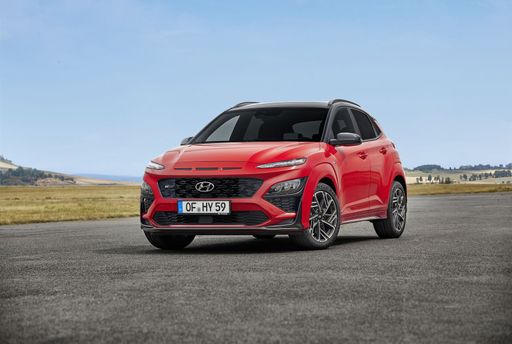 @ Hyundai Motor Company
@ Hyundai Motor Company
Hyundai Kona
Hyundai Kona
The Hyundai Kona wears its personality on the outside with bold styling and sprightly handling that turns city driving into something a little more fun than a commute. It blends practical space, modern tech and sensible running costs into a compact, stylish package — a smart pick if you want flair without paying luxury prices.
details @ Hyundai Motor Company
@ Hyundai Motor Company
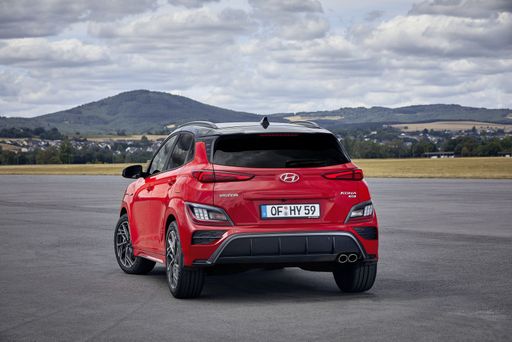 @ Hyundai Motor Company
@ Hyundai Motor Company
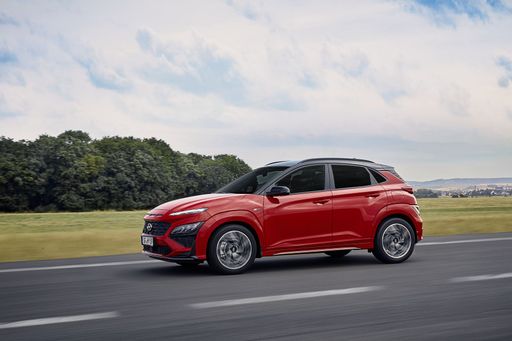 @ Hyundai Motor Company
@ Hyundai Motor Company
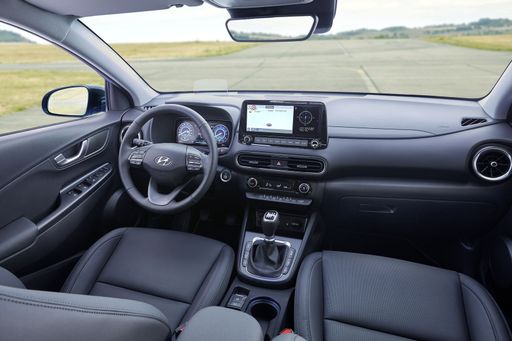 @ Hyundai Motor Company
@ Hyundai Motor Company
VW T-Roc
The VW T-Roc mixes cheeky, coupe-like styling with the everyday sense and space of an SUV, so it looks fun without sacrificing family sense. It’s a likeable all-rounder with tidy road manners and plenty of personality, ideal if you want a car that’s practical enough for chores but entertaining enough to enjoy.
details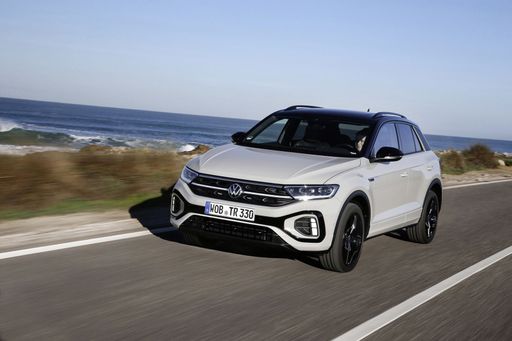 @ Volkswagen AG / VW Media
@ Volkswagen AG / VW Media
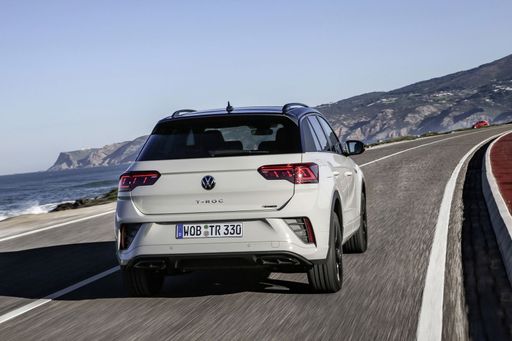 @ Volkswagen AG / VW Media
@ Volkswagen AG / VW Media
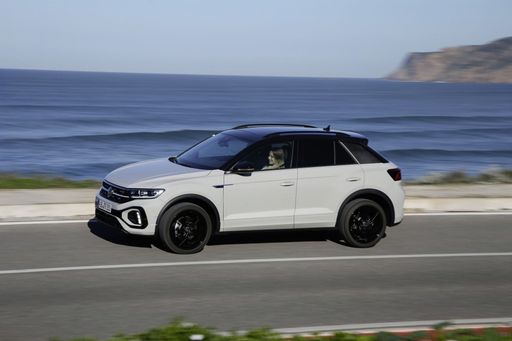 @ Volkswagen AG / VW Media
@ Volkswagen AG / VW Media
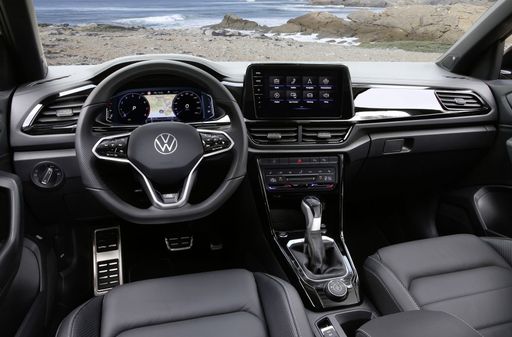 @ Volkswagen AG / VW Media
@ Volkswagen AG / VW Media
 @ Hyundai Motor Company
@ Hyundai Motor Company
|
 @ Volkswagen AG / VW Media
@ Volkswagen AG / VW Media
|
|
|
|
Costs and Consumption |
|
|---|---|
|
Price
23100 - 41600 £
|
Price
26400 - 38000 £
|
|
Consumption L/100km
4.6 - 7 L
|
Consumption L/100km
5.5 - 6.3 L
|
|
Consumption kWh/100km
14.6 - 16.8 kWh
|
Consumption kWh/100km
-
|
|
Electric Range
377 - 514 km
|
Electric Range
-
|
|
Battery Capacity
1.3 - 65.4 kWh
|
Battery Capacity
-
|
|
co2
0 - 163 g/km
|
co2
126 - 143 g/km
|
|
Fuel tank capacity
38 - 47 L
|
Fuel tank capacity
50 L
|
Dimensions and Body |
|
|---|---|
|
Body Type
SUV
|
Body Type
SUV
|
|
Seats
5
|
Seats
4 - 5
|
|
Doors
5
|
Doors
2 - 5
|
|
Curb weight
1370 - 1773 kg
|
Curb weight
1465 - 1539 kg
|
|
Trunk capacity
466 L
|
Trunk capacity
284 - 475 L
|
|
Length
4350 - 4385 mm
|
Length
4271 - 4373 mm
|
|
Width
1825 mm
|
Width
1811 - 1828 mm
|
|
Height
1580 - 1585 mm
|
Height
1527 - 1573 mm
|
|
Max trunk capacity
1300 L
|
Max trunk capacity
1350 L
|
|
Payload
420 - 490 kg
|
Payload
368 - 515 kg
|
Engine and Performance |
|
|---|---|
|
Engine Type
Electric, Petrol, Full Hybrid
|
Engine Type
Petrol, Petrol MHEV
|
|
Transmission
Automatic, Manuel
|
Transmission
Manuel, Automatic
|
|
Transmission Detail
Reduction Gearbox, Manual Gearbox, Dual-Clutch Automatic
|
Transmission Detail
Manual Gearbox, Dual-Clutch Automatic
|
|
Drive Type
Front-Wheel Drive, All-Wheel Drive
|
Drive Type
Front-Wheel Drive
|
|
Power HP
115 - 218 HP
|
Power HP
115 - 150 HP
|
|
Acceleration 0-100km/h
7.8 - 11.9 s
|
Acceleration 0-100km/h
8.9 - 12.3 s
|
|
Max Speed
162 - 210 km/h
|
Max Speed
187 - 212 km/h
|
|
Torque
200 - 265 Nm
|
Torque
200 - 250 Nm
|
|
Number of Cylinders
3 - 4
|
Number of Cylinders
3 - 4
|
|
Power kW
85 - 160 kW
|
Power kW
85 - 110 kW
|
|
Engine capacity
998 - 1598 cm3
|
Engine capacity
999 - 1498 cm3
|
General |
|
|---|---|
|
Model Year
2024 - 2025
|
Model Year
2024 - 2025
|
|
CO2 Efficiency Class
A, D, C, E, F
|
CO2 Efficiency Class
E, D
|
|
Brand
Hyundai
|
Brand
VW
|
Is the Hyundai Kona offered with different drivetrains?
Available configurations include Front-Wheel Drive or All-Wheel Drive.
The prices and data displayed are estimates based on German list prices and may vary by country. This information is not legally binding.
